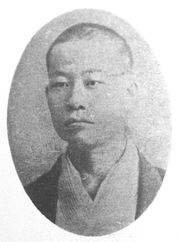
Koda Rohan
Encyclopedia

who used the pen name was a Japanese
Japanese people
The are an ethnic group originating in the Japanese archipelago and are the predominant ethnic group of Japan. Worldwide, approximately 130 million people are of Japanese descent; of these, approximately 127 million are residents of Japan. People of Japanese ancestry who live in other countries...
author
Author
An author is broadly defined as "the person who originates or gives existence to anything" and that authorship determines responsibility for what is created. Narrowly defined, an author is the originator of any written work.-Legal significance:...
in the Meiji period
Meiji period
The , also known as the Meiji era, is a Japanese era which extended from September 1868 through July 1912. This period represents the first half of the Empire of Japan.- Meiji Restoration and the emperor :...
. His daughter, Aya Kōda
Aya Kōda
was a Japanese essayist and novelist. She was the second daughter of Meiji period novelist Kōda Rohan. Her daughter Aoki Tama and granddaughter Nao Aoki were also writers....
, was also a noted author who often wrote about him.
Kōda wrote "The Icon of Liberty", also known as "The Buddha of Art" or "The Elegant Buddha", in 1889. A house (Kagyu-an or "snail cottage") in which Kōda lived was rebuilt in 1972 by the Meiji Mura
Meiji Mura
is an open-air architectural museum/theme park in Inuyama, near Nagoya in Aichi prefecture, Japan. It was opened on March 18, 1965. The museum preserves historic buildings from Japan's Meiji , Taisho , and early Shōwa periods. Over 60 historical buildings have been moved and reconstructed onto of...
museum. Kōda was one of the first persons to be awarded the Order of Culture
Order of Culture
The is a Japanese order, established on February 11, 1937. The order has one class only, and may be awarded to men and women for contributions to Japan's art, literature or culture; recipients of the order also receive an annuity for life...
when it was established in 1937.
Early Life
Rohan was born in the KandaKanda
-People:*Aika Kanda, a Japanese announcer of NHK*Hiroyuki Kanda, a top Japanese chef, and his eponymous Kanda restaurant in Roppongi, one of only 8 restaurants in Japan to earn 3 Michelin stars*Masaki Kanda, a Japanese actor...
District of Tokyo
Tokyo
, ; officially , is one of the 47 prefectures of Japan. Tokyo is the capital of Japan, the center of the Greater Tokyo Area, and the largest metropolitan area of Japan. It is the seat of the Japanese government and the Imperial Palace, and the home of the Japanese Imperial Family...
. He was the son of Koda Shigenobu (1839?--1914) and Koda Yu (1842?-1919), whose father was Koda Ritei, a samurai
Samurai
is the term for the military nobility of pre-industrial Japan. According to translator William Scott Wilson: "In Chinese, the character 侍 was originally a verb meaning to wait upon or accompany a person in the upper ranks of society, and this is also true of the original term in Japanese, saburau...
official serving under the local shogun
Shogun
A was one of the hereditary military dictators of Japan from 1192 to 1867. In this period, the shoguns, or their shikken regents , were the de facto rulers of Japan though they were nominally appointed by the emperor...
. Rohan's childhood name was Tetsushiro ("shiro" implying the fourth son) Shigeyuki.
Notable Short Stories
- "Dewdrops" (1889)
- "Love Bodhisattva" (1889)
- "Encounter with a Skull" (1890)
- "A Sealed Letter" (1890)
- "The Five-Storied Pagoda" (1891) (translated into English as The Pagoda)
In Fiction
Kōda Rohan, along with many other historical figures from the Meiji RestorationMeiji Restoration
The , also known as the Meiji Ishin, Revolution, Reform or Renewal, was a chain of events that restored imperial rule to Japan in 1868...
, plays a major role in the fantasy/historical fiction novel Teito Monogatari
Teito Monogatari
is a massive Japanese historical fantasy epic written by Hiroshi Aramata.-Overview:The story is a retelling of the history of Edo from an occultist perspective. The premise is based on the idea that the curse of Taira no Masakado greatly influenced the city's history from its inception to the...
by Aramata Hiroshi
Hiroshi Aramata
is a Japanese author, translator, and screenplay writer, as well as a specialist in natural history and cartography.His most popular novel was Teito Monogatari , which has sold over 3.5 million copies in Japan alone. He also wrote Alexander Senki, a novel which eventually evolved into the anime...
.

